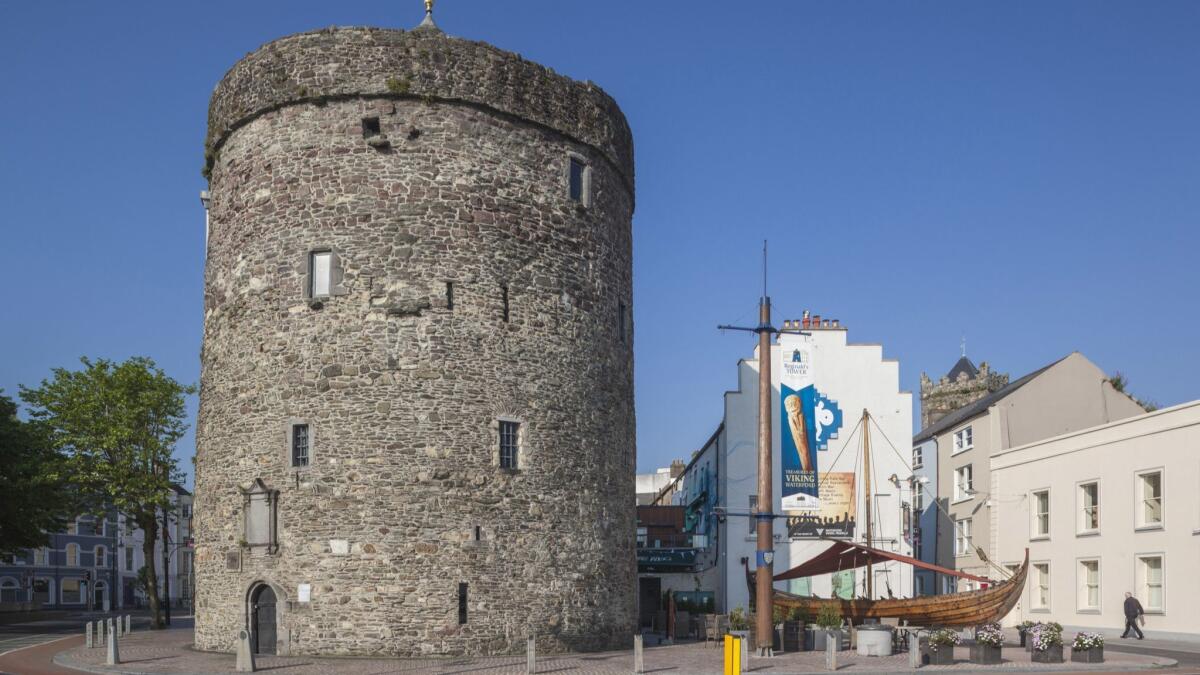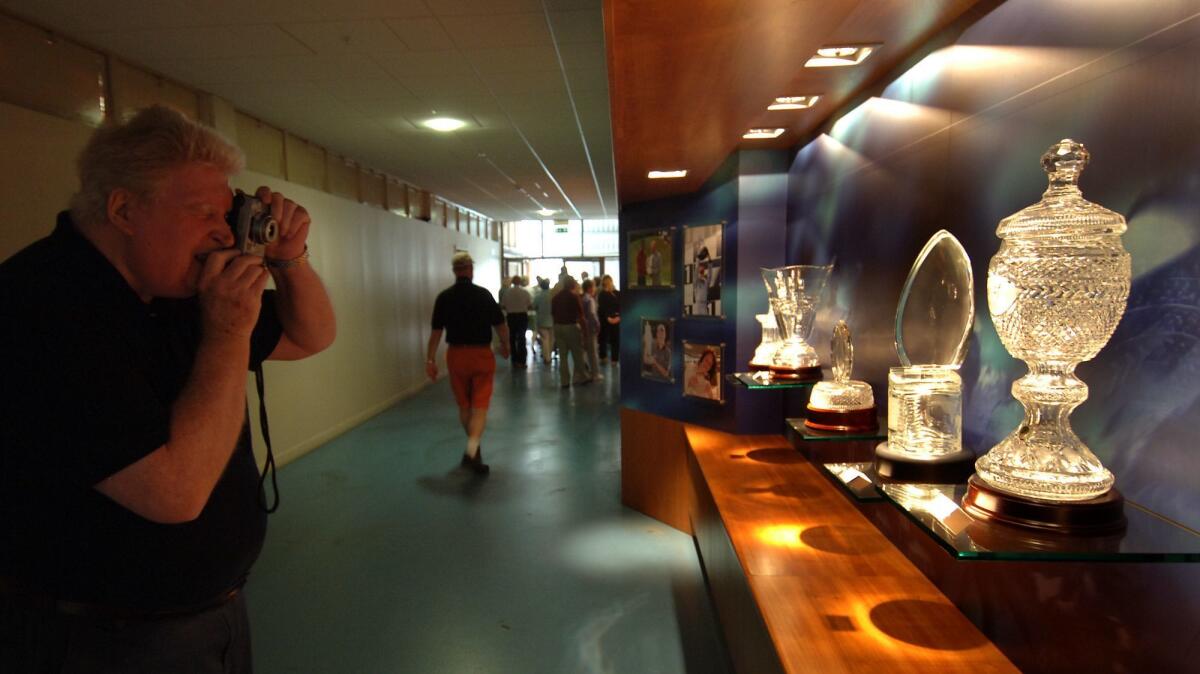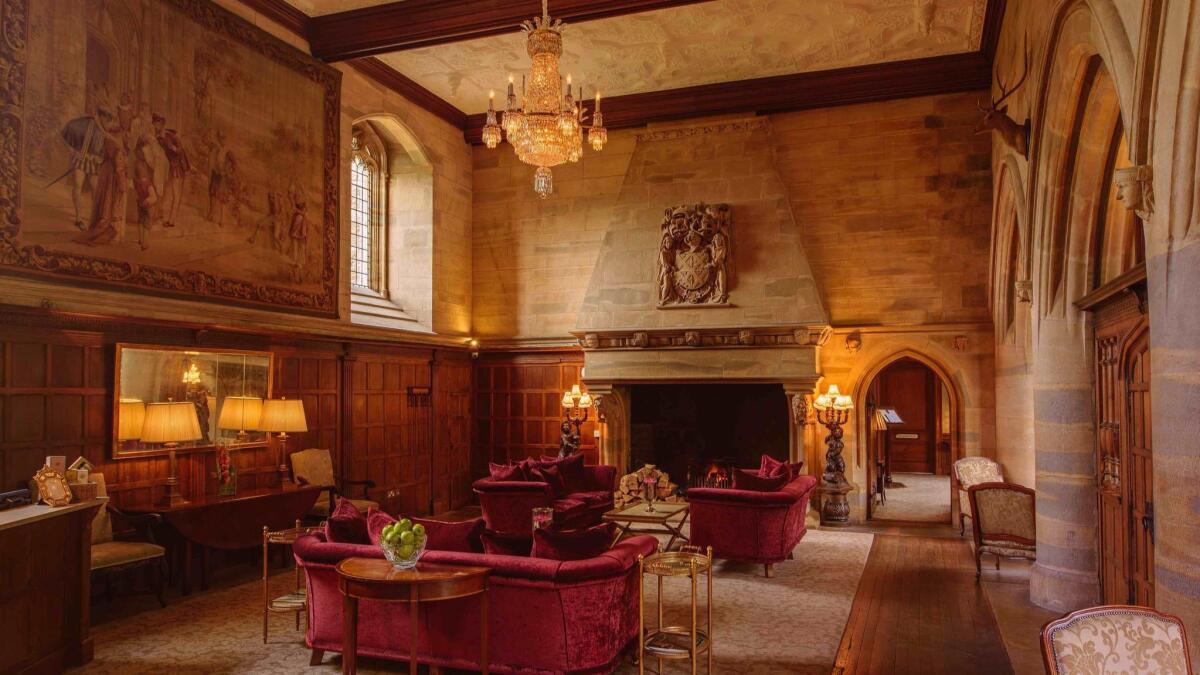Waterford, once the capital of crystal, looks beyond its famed factory and embraces a brilliant history
Reporting from Waterford, Ireland — Visitors to this small city on the southern coast of Ireland often arrive by the bus load, stopping at the futuristic black glass and chrome headquarters of Waterford Crystal and leaving as soon as the tour is done.
That’s no surprise; for many people, the famed crystal is the only reason they’ve heard of Waterford.
But after spending more than a month here recently with my wife, awaiting the birth of our first grandchild — she was taking her own sweet time arriving (just like a journalist’s grandkid to miss deadline) — I discovered there is more to this place than fancy glass, most of which is produced in Slovenia these days.
Waterford, a city of about 50,000 a couple hours south of Dublin, has many stories to tell.
The Vikings founded it in the 10th century, making it the oldest city in Ireland. Indeed, it has played a giant role in many of the signal events in Irish history.
Now it is trying to use that history to encourage those crystal-gazing tourists to stay a little longer.
Three splendid small museums — two of which have opened in the last six years — showcase Waterford’s rich heritage. They are next to one another in the old district known as the Viking Triangle, across from the Waterford Crystal factory.
The city is moving forward by looking back with the motto “1,000 years in 1,000 paces.”
As I walked to each museum over a couple of days, I was able to trace the history of Waterford from its founding by the Vikings right up to the present.
I was fascinated thinking about the Viking trade route that brought to Ireland a more than 1,000-year-old coin that had been minted in what is now Iraq.
I can’t imagine anything more breathtakingly beautiful than the Cloth of Gold priest’s vestments, especially when you add the fact that they had lain hidden for more than 100 years under a church floor.
And it was remarkable to stand on the site of the 12th century wedding that cemented the English hold over the Irish.
History is everywhere
Granted, the last several decades have not been kind to Waterford.
First, business at its shipping port, once Ireland’s second busiest, dwindled dramatically. It is now fifth.
Then, in 2009, the famed crystal factory, which had employed thousands of highly paid skilled craftsmen, shipped most of its work overseas, leaving a gleaming new facility staffed by a handful of workers creating sporting trophies and other signature pieces.
Those twin blows devastated the city’s economy, and it is just beginning to bounce back. Much of the downtown area is shabby and reminiscent of a small Rust Belt city in the American Midwest, albeit one laced with centuries-old stone walls.
Despite that, history still stands tall in Waterford.
That stone wall I leaned against while slurping oysters, drinking ale and listening to music at the Reg restaurant is a fragment of one built by the Vikings at the turn of the first millennium.
To get to the Tesco supermarket, where I bought ingredients for stews and soups to freeze and thus tide over the prospective parents, I passed a gate built by Anglo-Normans in the 12th or 13th century.
The City Square Shopping Centre was built on the site of the 12th century St. Peter’s Church.
When I peered through the glass wall to look at the preserved foundation, that sight mixed surrealistically with the reflection of the brightly illuminated soda machine and a child’s mechanical pony ride behind me.
Reginald’s Tower, an imposing fortress built on the site of the Vikings’ first permanent settlement, anchors the three featured museums across the old quay from the River Suir (pronounced, you almost certainly will be told, “sure,” not “sewer”).
The current stone structure was built in the 12th century, replacing the original wooden one from 914. The exhibits include an intricate silver, gold foil and amethyst-colored glass kite brooch from the 12th century and, most impressive to me, an 8th century Islamic coin that had been minted in Wasit, a town near present-day Baghdad.
I found myself wishing I had brought a couple of pre-teens with me when I stopped at the King of the Vikings virtual-reality adventure. It’s cheesy and violent enough to thrill tweens, and historically well-grounded enough for adults. Even a grandfather-in-waiting like me found the VR effects cool.

Hidden treasure
Next door is the Medieval Museum, which opened in 2013. One exhibit documents Waterford’s role in one of the most historic weddings in European history.
In the 12th century, when Ireland was a battlefield for competing clans, one tribal leader enlisted the military help of Englishman Richard de Clare, known as Strongbow.
Victorious on the battlefield, Strongbow was rewarded with marriage to the chieftain’s daughter, thus consolidating the English influence over the island that continues to this day.
The grand Georgian Christ Church Cathedral, directly behind the museum, stands on the site of the church where the wedding took place.
That cathedral was also the site of the discovery of one of the museum’s most stunning treasures. In 1773, when the old Gothic cathedral was demolished to build the current version, workmen found a chest that had been buried under the chapel floor.
When they opened it, they found a Catholic priest’s vestments of almost unimaginable beauty.
They had been created in the 15th century from spun-gold Florentine cloth and embroidered in Bruges, Belgium. The vestments were buried in 1650 to keep them out of the hands of the Protestant Oliver Cromwell, who was besieging the city. (One of his cannonballs is still visible, lodged in Reginald’s Tower.)
After Cromwell’s victory, the Catholic Church was outlawed, and the hidden treasure faded from memory until it was uncovered 123 years later.
Completing the three museums is the Bishop’s Palace, which celebrates the city’s Georgian and Victorian days, when it was one of the most important commercial hubs in Britain.
It was the home of the Anglican bishop of Waterford. The first two floors are devoted to the lives of the wealthy Anglo-Irish.
But it was the third floor, devoted to the modern period, that fascinated me most. Waterford was one of the hotbeds of the Irish independence movement. In fact, Thomas Francis Meagher, a son of the city’s wealthiest family, designed the Irish tricolor and first flew it across the street from the Bishop’s Palace.
The exhibit covers the independence movement up through the 1916 rebellion and beyond but also touches on more everyday matters such as popular music, films and even the workings of the Ballybricken pig market.
Of course, visiting Waterford without stopping at the crystal factory is almost unthinkable. It is fascinating to watch the remaining artisans at work. The hour-long tour covers the blowing, carving and engraving of crystal and ends in an elaborate gift shop.
The reductions at the factory have also created a diaspora of craftsmen.
Sean Egan, one of the displaced, has set up shop on the ground floor of the Bishop’s Palace, where you can watch him carve and engrave crystal.
Just steps away is the Irish Handmade Glass Co. Here you can wander by and watch a generally younger, perhaps hipper, group of craftsmen create fine crystal for more modern tastes (and at lower prices), some as vividly colored as Italian Murano glass.
Time also marches forward, even in Waterford.

Irish soul food
Waterford is in the early stages of the great Irish food awakening that has already swept much of the island.
It’s a rare menu here that doesn’t feature hamburgers, kebabs and pizzas. Potatoes are omnipresent. They once appeared in place of rice on a takeout order from a Thai restaurant.
That’s not to say there isn’t good food in Waterford. You just have to search for it.
On the plus side, little of it has been “re-interpreted.” This is Irish soul food — meat and fish pies, seafood chowders and fish and chips.
Perhaps most glorious is something called “bacon ribs.” These are the very short ribs from under the pork belly that have been salted like corned beef, then braised until the meat is falling off the bone and served over colcannon — potatoes mashed with kale or cabbage. Spoon over parsley sauce as they do at the Munster Bar (Bailey’s New Street, 51-874-656, themunsterbar.com, sandwiches from $8, restaurant entrees from $12.30), and it’s hard to imagine anything better on a damp Irish evening (Redundant, perhaps? Most Irish evenings are damp.)
If you’re looking for a more contemporary approach, check out the Granary Cafe (Hanover Street, 011-353-51-854-428, granarycafe.ie), a hip lunch counter attached to a school of architecture, or Grow HQ (Farronshoneen, Dunmore Road; 011-353-584-422, giy.ie/grow-hq, main dishes from $14), a garden-to-table restaurant that grows much of its own vegetables. For something a little posher, the locals love Momo (47 Patrick St., 011-353-051 581-509, momorestaurant.ie, mains from $20 to $30).
If you just want a friendly pub, you won’t have far to go. I have a soft spot for Philly’s — formally known as Phil Grimes Pub (60 Johnstown, 011-353-51875-759, lat.ms/philgrimespub). It has a terrific selection of local craft beers and ciders, a lively crowd, a great jukebox and a friendly publican.
If you go
THE BEST WAY TO DUBLIN, IRELAND
From LAX, Aer Lingus offers nonstop service to Dublin, and Delta, United, American and British offer connecting service (change of planes). Restricted round-trip service from $833, including taxes and fees.
TELEPHONES
To call the numbers below from the United States, dial 011 (the international calling code), 353 (the country code for Ireland), 51 (the city code for Waterford) and the local number.
WHERE TO STAY
The grandest place to stay in Waterford is not in Waterford at all, but about a 20-minute drive from the city. The Waterford Castle Resort (The Island, 878-203, waterfordcastleresort.com, doubles from $350) is built around a 16th century castle on a 300-acre island. It’s reachable only by ferry.

Thomas Francis Meagher’s family home, given pride of place right in the middle of the old docks, has been converted into the Hotel Granville (Meagher Quay, 305-555, granvillehotel.ie, doubles from $185). It’s gracious, but a little stodgy.
My wife and I stayed at the Waterford Marina Hotel (Canada Street, 856-600, waterfordmarinahotel.com, doubles from $150) affordable and well-run. It’s right on the Suir and a 10-minute walk from the historic district. The restaurant, called the Waterfront Bistro, is particularly good.
TO LEARN MORE
Visit Waterford, www.visitwaterford.com
Waterford Treasures, www.waterfordtreasures.com
More to Read
Sign up for The Wild
We’ll help you find the best places to hike, bike and run, as well as the perfect silent spots for meditation and yoga.
You may occasionally receive promotional content from the Los Angeles Times.





